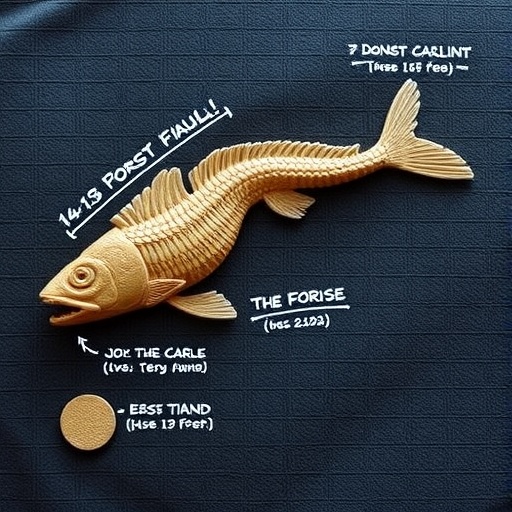In a groundbreaking discovery poised to redefine our understanding of early vertebrate evolution, researchers at the University of Michigan have identified the earliest known example of a specialized biting apparatus in an ancient ray-finned fish, Platysomus. This remarkable finding, elucidated through advanced imaging techniques, reveals a complex adaptation involving tooth plates supported by gill bones that functioned much like a tongue to process food. The revelation, dating back approximately 310 million years to the Pennsylvanian period, highlights a pivotal evolutionary innovation that shaped feeding mechanics in aquatic vertebrates.
Platysomus, a member of the ray-finned fishes (Actinopterygii), inhabited the shallow waters of Earth’s ancient ecosystems during the early Carboniferous. This group, which today includes familiar species such as goldfish, tuna, and salmon, was already exploring ecological niches and feeding strategies that would become fundamental to their vast radiation over millions of years. Central to this new study is the discovery of a plate of teeth on the floor of Platysomus’s mouth, structurally cradled by a network of jointed bones that also supported the gills. This ‘tongue bite’ apparatus allowed the fish to efficiently crush and grind hard prey, marking a significant stride in functional feeding evolution.
The University of Michigan’s paleontologist Matt Friedman, who spearheaded the research team, describes this dental plate arrangement as a convergent evolutionary strategy. The bite mechanism was directly opposed to a corresponding tooth plate in the upper jaw, providing a powerful crushing capability reminiscent of a tongue’s movement. What makes this adaptation particularly fascinating is its convergence: despite rising independently in multiple fish lineages over time, this biting innovation emerged first in Platysomus, underscoring certain evolutionary constraints and preferred developmental pathways in vertebrate anatomy.
Adaptations such as this shed light on how biological organisms respond to environmental pressures by evolving specialized anatomical structures. Friedman’s insights emphasize that convergent evolution—the independent appearance of similar traits in distinct lineages—is not merely coincidence but reflects underlying biomechanical and developmental potentials that certain evolutionary trajectories are predisposed to follow. The tongue bite function exemplifies how ancient fishes optimized their feeding to exploit hard-shelled prey, a selective force that continues to shape aquatic biodiversity today.
Studying deep-bodied fish like Platysomus presents unique challenges due to fossilization processes. Platysomus’s flattened body morphology, similar in shape to modern angelfish, means that when these animals are fossilized, the delicate internal structures tend to be compressed, obscuring key details. Most fossil fish are preserved lying on their sides, capturing external morphology but often masking internal skeletal architectures critical for understanding functional anatomy. Overcoming these limitations required Friedman to scour extensive museum collections for exceptionally preserved specimens that retained three-dimensional integrity.
The breakthrough came with high-resolution CT scans of uncrushed Platysomus skulls housed in UK museums. These scans unveiled a complex and previously unseen internal architecture of gill-supporting bones integrated with dental plates on the mouth floor. The exquisite preservation allowed the researchers to digitally reconstruct the feeding apparatus, uncovering a sophisticated mechanism that was invisible in typical flattened fossils. This technological leap in paleontology facilitates the extraction of evolutionary and functional data from long-studied but physically constrained specimens.
Comparative analyses link the biting plates of Platysomus to those found in modern-day bonefish, which inhabit tropical and subtropical waters and exhibit similar feeding strategies, primarily preying on hard-shelled organisms such as crabs. The evolutionary parallel bolsters the idea that this ‘tongue bite’ structure is highly effective for processing durable food items, an adaptation that multiple fish clades have rediscovered independently. Such repeated evolutionary solutions speak to the biomechanical efficiency underlying the trait.
The significance of this discovery extends beyond evolutionary biology into museum sciences and fossil curation. The key specimen that revealed the tongue bite was likely collected over a century ago but had not been extensively analyzed until recently. With the advent of cutting-edge imaging techniques such as CT scanning, long-established collections become invaluable reservoirs of new knowledge. Friedman highlights that paleontological innovation lies not only in field excavation but increasingly in the reexamination of archived materials through modern technology.
This research also advances broader discussions in evolutionary developmental biology regarding constraints and potentials in anatomical innovation. By tracing how different groups of ray-finned fishes evolved similar structures independently, scientists can better understand the genetic and developmental pathways facilitating these adaptations. Identifying common patterns in convergent evolution helps elucidate the limitations and opportunities that govern the course of life’s diversification over geological timescales.
The findings were published in the journal Biology Letters and were supported by funding from the U.S. National Science Foundation. Collaborators on the study include Sam Giles of the University of Birmingham and Matthew Kolmann of the University of Louisville, emphasizing an international effort to comprehend early vertebrate functional morphology through paleontological research.
Ultimately, the discovery of the tongue bite apparatus in Platysomus enriches the narrative of vertebrate evolution by pinpointing a moment when the architecture of feeding mechanics took a decisive leap forward. It underscores the enduring relevance of museum collections in evolutionary research and the necessity of integrating traditional paleontological practices with state-of-the-art imaging technologies to unlock Earth’s deep biological history.
Subject of Research: Animals
Article Title: Tongue bite apparatus highlights functional innovation in a 310-million-year-old ray-finned fish
News Publication Date: 3-Sep-2025
Web References: http://dx.doi.org/10.1098/rsbl.2025.0270
Image Credits: Credit/Joschua Knüppe
Keywords: Physical sciences, Paleontology




